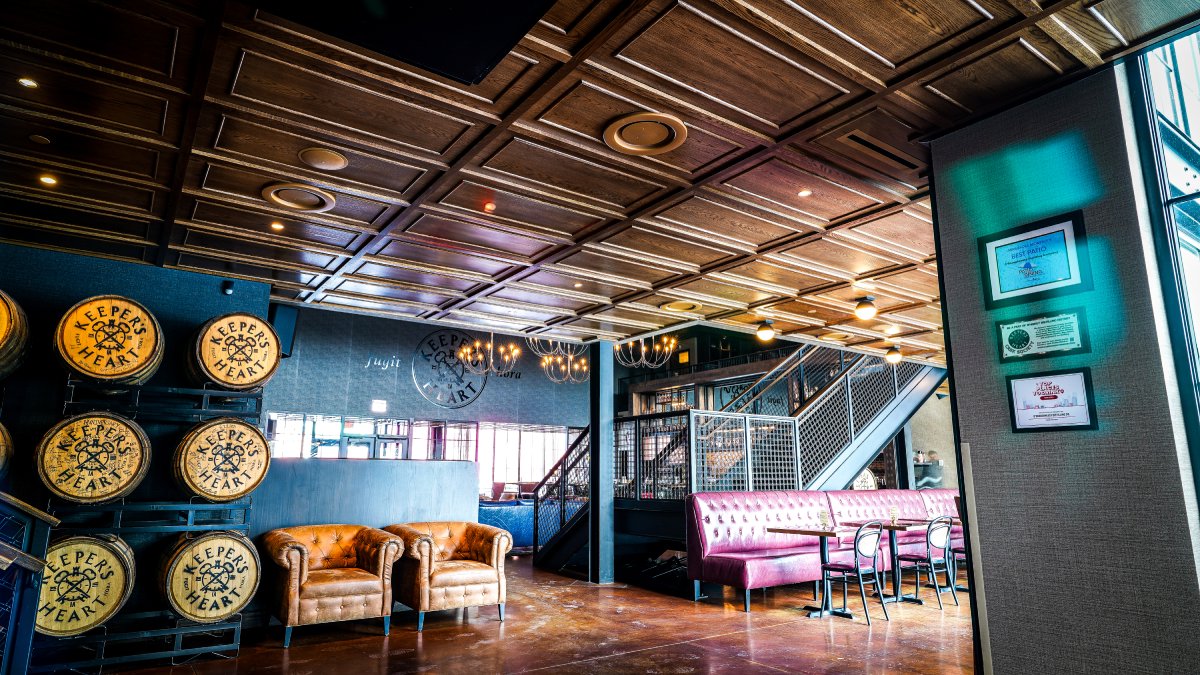
Coffered Ceiling Ideas for Commercial Spaces: Modern Elegance in Architectural Design
In architectural ceiling design, few are as sophisticated, dimensional, or dramatic as the coffered ceiling. No longer just for palaces, cathedrals and government buildings, coffers are having a major revival in commercial interiors. Merging classic beauty with functional performance, today’s ceiling coffers offer architects and designers tools to control acoustics, conceal building systems, and create a geometry that makes a statement. With so many ideas for coffered ceilings available on the market, designers can escape traditionalism to create unique, branded environments.
In this article, we’ll take a look at coffered ceiling ideas for commercial interiors from classic wood coffer ceilings to modern geometric grids. We’ll explore the spaces where they perform best, the latest design trends, and how ASI Architectural’s Coffer system is helping architects and designers realize contemporary ceiling treatments on a large scale.
What Are Coffered Ceilings?
For those new to architectural design, the question of what is a coffered ceiling is easily answered: it’s a structured grid of recessed panels that adds both performance and prestige.
At their most basic, coffered ceilings are a grid or series of recessed panels, typically squares or rectangles, framed by beams or molding. This geometric rhythm creates depth and texture overhead, drawing the eye upward while adding visual and acoustic dimension.
Historical Roots
The earliest coffered ceilings date back to ancient Greece and Rome, where carved stone coffers were as much about reducing ceiling weight as they were about enhancing visual grandeur. Over time, coffers became staples of Renaissance churches, parliamentary buildings, and libraries.
Modern Functionality
Nowadays, modern coffered ceiling systems can:
- Enhance the acoustics of auditoriums, lecture halls, or performance spaces
- Hide HVAC ducts, sprinkler systems, or wiring within the recessed grid
- Provide modular coffered ceiling tile options that can make installation and maintenance easier in commercial projects
In short, what was once purely decorative has become a highly adaptable architectural ceiling design solution that combines beauty with real-world function.

Example of ASI Coffer in a restaurant
Are Coffered Ceilings Still in Style?
If anything, the coffered ceiling is having a design moment. While the carved coffer once evoked history and permanence, today’s ceilings are all about sleek lines, precision woodworking, and integration with the building systems beneath. Here’s why coffered ceilings are trending now:
- Timelessness: The coffered ceiling is one of the only ceiling treatments that looks just as modern today as it did 100 years ago. Symmetry and geometric regularity simply don’t go out of style.
- Warmth and materiality: One of the hottest design trends for any interior is biophilic design, which focuses on connecting people to the natural environment through their physical surroundings. Natural wood coffered ceilings fit right into this aesthetic.
- Performance: From lighting integration and concealed acoustics to an architecture friendly build, coffered ceilings are just plain practical.
- Brand alignment: Upscale offices, government buildings, and cultural institutions looking for a specific identity are also reaching for coffered ceilings to convey authority, tradition, and sophistication. Current architecture trends highlight ceilings as focal points, with coffered grids offering designers a way to blend timeless structure with modern performance.
From boardrooms to client-facing suites, coffered ceilings have become synonymous with upscale office interiors that project authority and brand strength. As one ASI Architectural designer puts it: “The ceiling is the fifth wall of a space. The right ceiling treatment can shape acoustics and the identity of a space.”
Best Commercial Spaces for Coffered Ceiling Applications
Coffered ceilings are a great enhancement to nearly any commercial interior. They are, however, a particularly good choice in larger spaces with needs for acoustics and a major visual statement. Some spaces where coffered ceilings work especially well include:
- Auditoriums and Performance Halls: The significant acoustical advantages of coffers makes them a natural choice for theaters and performance venues.
- Corporate Lobbies: Nothing greets visitors and clients like a ceiling treatment that makes a statement and sets the tone for the rest of the building. A dramatic ceiling design for lobbies can instantly set the tone for a corporate headquarters, hotel or civic building.
- Boardrooms and Executive Suites: Wood panel ceilings in executive suites are often signs of prestige and leadership.
- Government Buildings and Courthouses: A courtroom ceiling with traditional coffers signals authority and permanence.
- Museums and Galleries: Patterned or geometric-shaped coffers can stylishly frame lighting and art displays.
- University Halls and Lecture Theaters: Acoustics are enhanced while long-term durability is supported.
- Libraries: Classical decorative ceiling panels in a library add to the sense of history and intellectual tradition.
In all of these spaces, coffered ceiling systems provide a visual wow factor and real-world performance. Although coffered ceiling cost can be impacted by the wood species, grid complexity and acoustic performance requirements, modular systems keep budgets predictable for large projects.
Coffered Ceiling Ideas for Commercial Interiors
Coffered ceilings aren’t a one-size-fits-all treatment. Designers can completely customize ceiling grid patterns, wood finishes, and even functions to the space at hand.
1. Using Warm Wood Tones
Deep finishes such as walnut or cherry add gravitas to executive suites, boardrooms, and financial institutions. Wood coffered ceilings in these darker, warmer colors exude authority while maintaining a traditional feel.
Design tip: Combine dark wood with recessed lighting and less-is-more molding details for a ceiling solution that feels current but also timeless.
2. Light-Toned Coffered Ceilings
Conversely, if you’re working with a space that could use more openness and brightness, like libraries, lecture halls and student centers, lighter finishes like maple or beech can work just fine. They’ll reflect light and visually open up a room while also providing the acoustic absorption you need in spaces where people gather and talk. The net result is an airy, uplifting acoustic wood ceiling that supports concentration and comfort.
3. Geometric Pattern Variations
Square coffers are standard, but today’s coffer systems allow for endless pattern variation. Rectangular layouts can visually stretch a room while hexagonal or diagonal grids create dramatic architectural focal points. By incorporating a recessed ceiling grid, designers can conceal infrastructure while adding depth and shadow to the room’s architecture.
Coffered systems also work well as a very effective ceiling solution for large spaces, where acoustic needs are as important as a dramatic architectural statement. In galleries or exhibit spaces, non-traditional coffering doubles as a ceiling solution while also serving as a visual wayfinding guide. Integrated lighting creates even more drama.
ASI’s Beam system can also be used to create a pattern that has the visual effect of being recessed. For instance, the beam design allows for a creative coffer grid that plays with shadow and rhythm.

Example of ASI’s Beam in use with commercial lighting
4. Emphasize Natural Textures
Wood coffered ceilings, when done with a species with a visible grain such as white oak or red oak, can lend warmth and an organic character to theaters, music halls, or auditoriums. Their natural wood grain can add to the architectural design and treatment of ceilings, while also offering improved acoustics for speech and music performance. A texture and performance combination like this can be impactful on spaces for cultural institutions where ceiling treatments are part of the experience for attendees.
5. Transitional Designs
A few environments call for something in between classic and modern, and hickory can help. Bold and structured, hickory offers a coffered ceiling that can bridge both worlds. In government or educational buildings, transitional coffered ceilings can integrate with columns, moldings, or other historic elements while maintaining a clean, more updated look. The net result is a sense of continuity with respect for the past and updated building performance in the present.
Timeless Design with Modern Performance
Coffered ceilings have endured for thousands of years because they solve both aesthetic and functional challenges. In commercial interiors today, they’re more than a decorative accent. They offer acoustic control, system concealment, and a strong architectural identity that can communicate a sense of sophistication.
With modular innovations like ASI Architectural’s Coffer system, architects and designers can achieve the depth and rhythm of traditional coffers with the modern-day precision, flexibility, and acoustic performance needed. Whether you’re installing a ceiling in a courtroom, a university lecture hall, or an upscale office interior, coffered ceiling systems offer scalable solutions that can help to elevate the entire environment.
If you’re considering coffered ceiling ideas for your commercial project, remember to balance wood tone, geometry, and performance. ASI’s experts can help you select the right materials and specifications to realize your vision.
Contact us today for a no obligation quote.




